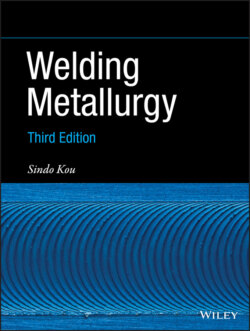Читать книгу Welding Metallurgy - Sindo Kou - Страница 54
1.6.3 Explosion and Magnetic‐Pulse Welding
ОглавлениеFigure 1.40 illustrates a solid‐state welding process in which a large force is suddenly generated to fast accelerate (e.g. to >500 m/s) one member (called flyer plate) of the workpiece to make it collide with the other member (called the base plate) at an angle (e.g. 15°). As the collision front moves forward fast, the materials near the interface, along with their surface oxide films, are expelled as a jet, allowing the fresh, oxide‐free materials to bond together firmly. At the interface between the two members, the material of the flyer plate moves forward very fast, but the material of the base plate is stationary. The mismatch in the forward moving speed causes a flow instability at the interface, resulting in a wavy interface. The wavy interface is clear if the two materials are similar in strength. However, it may not be as clear if one material is much harder than the other such as steel and Al.
Figure 1.40 Schematic illustration of solid‐state joining by making one member (flyer) of the workpiece fast collide with a stationary member (base), such as explosion welding or magnetic impulse welding.
In the explosion welding (EXW) process, the sudden force is caused by an explosive. In the magnetic‐pulse welding (MPW) process, on the other hand, an instant electromagnetic force is generated by a fast discharge of capacitors into a coil (e.g. 500 kA) to cause a high pulsed current (e.g. 500 kA and 15 kHz). The pulsed current produces a high‐density magnetic field, creating an eddy current in one member of the workpiece and a repulsive force to accelerate it to collide with the other member. The high collision velocity (e.g. 500 m/s) causes the two members to be welded together upon impact.
EXW or MPW have two main advantages:
1 Excellent welds can be made between different metals, with hardly any brittle intermetallic compounds.
2 The joint strength can be close to that of the base metal.
They have three main disadvantages:
1 Explosion welding is expensive and requires a special license.
2 Magnetic pulse welding equipment is expensive.
3 Limited to joint designs with overlapping between two members of the workpiece.
